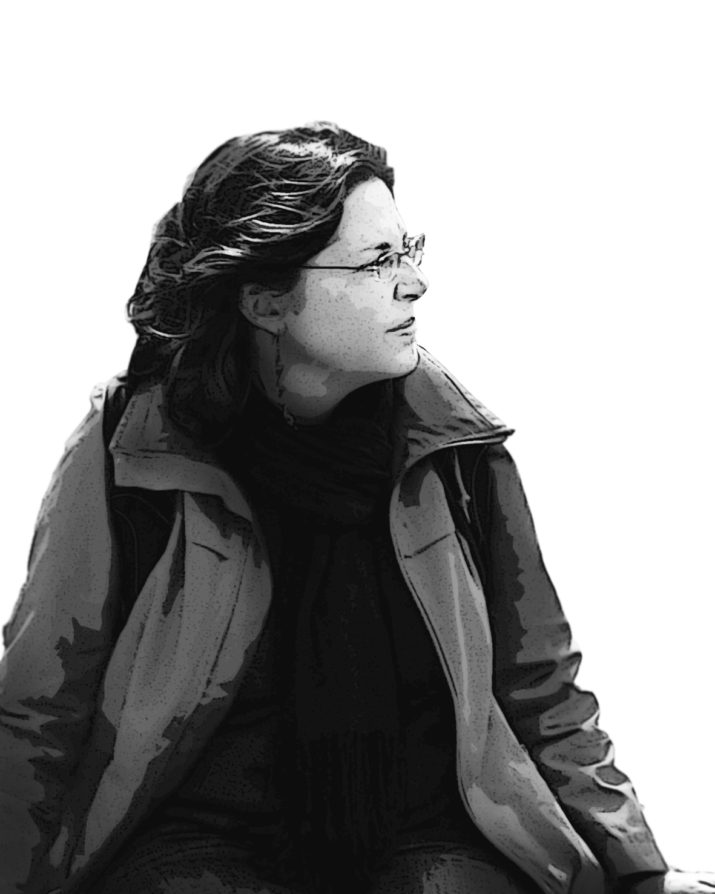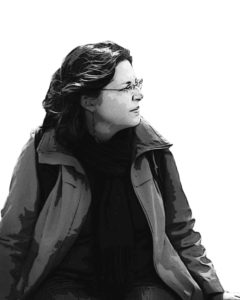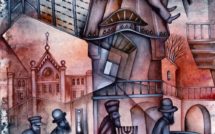

In this interview, Dr. Viejo-Rose talks about disputed memory and the socio-politics of the past, explaining why she is deeply concerned with how “cultural heritage is used and abused during armed conflicts and in their aftermath, to divide, exclude, and intimidate.”
Unravelling contested histories, probing the complexity and contradictions of the politics of remembrance, and the contested material and psychological landscapes of our lives, Dacia is committed to examining “ways of ‘disarming’ heritage, so that it can be a tool for constructive dialogue, dignity, and respect.”
Dacia grew up in Spain in the waning days of the Franco regime. Her father, a journalist engaged in clandestine resistance against Franco, eventually emigrated to the US and became a translator for the UN. Her mother earned her doctorate in art history. Dacia’s work is heavily imbued with both a profound sense of social justice and responsibility and respect for the arts, history, museums, and heritage, reflecting, as she acknowledges, her efforts “to do justice to and pay her respects to the interests of both her parents.”
Upon graduating college, while interning at the United Nations Department for Humanitarian Affairs in Geneva, she was exposed to the aftermath of the war in Bosnia, the fallout of the Rwandan genocide, and disastrous floods in Cambodia; an experience that sparked her interest in the violence and aftermaths of man-made and natural disasters.
Subsequently, at UNESCO, she observed the diplomatic wrangling and eventual drafting of what would become the Convention for the Safeguarding of Intangible Heritage (2003) and the Convention on the Protection and Promotion of the Diversity of Cultural Expressions (2005).
Bringing these two worlds of crisis and culture together, Dacia’s on-going research interests lie at the nexus between cultural heritage and the politics of the past. She sensitively understands the fluidity, complexity and contradictions of her subject, describing how “heritage has come to resemble a protean creature.”
—Sherman Teichman for EuropeNow
EuropeNow What drew you to this pursuit?
Dacia Viejo-Rose It was while I was at UNESCO that the strands of my interests came together and I found my “thing.” I was there at an exciting moment; the organization had a mandate for implementing the Dayton Peace Accords in terms of its specialist areas—so, cooperation between the countries of the former Yugoslavia on areas of culture, science, and education—and the first drafts of what would become the Convention for the Safeguarding of Intangible Heritage (2003) and the Convention on the Protection and Promotion of the Diversity of Cultural Expressions (2005) were being hammered out. In relation to the first of these, I was able to sit in on meetings between representatives—ministers and ambassadors—of these countries, and to read through the projects being developed by the Culture Sector in this regard. This is how I came to learn about the project for the reconstruction of the Mostar Bridge, among many others. It was that bridge, and the project to rebuild it, that became a pivotal moment for me
On paper, the project was everything that I had hoped for and thrilled me, as here was a way to use culture, cultural heritage, as an instrument in peace-building and recovery. Not only did the project aim to rebuild the bridge itself as materially authentically as possible, but in doing so, and drawing on the strong bridging metaphor, it aimed to reconstruct the links between the communities of the town that had been severed by the war. The use of such a symbolic heritage site to motor peace and recovery through the celebration of its universal values was irresistibly seductive to me. Then, I went to Bosnia and Herzegovina, to Sarajevo to see how the reconstruction of the town’s multicultural and religious heritage was being rebuilt, to Mostar to see the final stages of the bridge’s reconstruction, and from there to Serbia and Belgrade to see how cultural heritage institutions were faring there. What I found on the ground came to me as a rude awakening.
In Mostar, I found the most divided town in the entire country, including segregated schooling such that children had to take turns using the same school building in order not to be taught together, with two football teams, and with a festering resentment around who had been consulted and who had benefited from the reconstruction of the bridge. From the conversations that I had on the ground, at best, the project for the reconstruction of the bridge had failed in its peace-building aims; at worst it had actually contributed to festering tensions and feelings of resentment. This was patently clear in the built landscape that emerged around the bridge with an enormous bell tower going up on one side of the river, and minarets on the other, competing visually, but also each filling the town’s sound-scape at regular intervals throughout the day in a mutually defiant clang-call. With this cacophony of impressions still ringing in my ears, I returned to UNESCO and told anyone who would listen about it. Of the various responses that I got, the most constructive one was this: we are doing the best that we can with good intentions but there is no research on this. So I left to do some of that missing research.
In this bout of research, I worked on how cultural heritage was being used in reconstruction and recovery projects in Bosnia with the aim of seeing what worked or not and why. This research convinced me that one of the problems with the way that the protection of cultural heritage was being approached was the assumption made that it has an inherently positive dimension—inclusive, celebratory of universal values, rallying and inducing of social cohesion – and as such a natural peace builder. But this assumption, upheld by the utopian vision and ideals of international heritage bodies and their attractive discourse, does not pan out on the ground. Cultural heritage can just as easily be used to exclude, intimidate, divide, and legitimize factional and fundamentalist aims. This realization lead to a further focus in my research on the (ab)uses of cultural heritage, and this began with trying to get a better understanding of the functions of heritage beyond its aesthetic or historic value.
EuropeNow So, what is heritage?
Dacia Viejo-Rose The idea of heritage has expanded tremendously since the 1972 World Heritage Convention. There, you see a categorization of heritage sites, with the natural and cultural sites running in parallel: monuments, groups of monuments, and monuments in a context/landscape. But since then, our understanding of heritage has been transformed; heritage has gone from being celebrated for its “thingyness” and historicity, and the authenticity and value thereof, to being appreciated as a process that uses the past as a resource to construct meaning in the present (Smith, Harvey). There is an alliteration of Ps that illustrates this semantic evolution: from heritage as property, to place, product, performance, project, and finally process. At the center of this transformation has been the shift in focus from protection, to interpretation.
On a practical level, heritage is increasingly asked to be delivered by policy-makers and politicians keen to justify their public spending, and by practitioners angling for recognition and resources for their work. As a result, high expectations have been put on heritage to contribute quantifiable outcomes to a vast field of issues, including urban renewal, job creation, sustainable development, peace and reconciliation, climate change mitigation, and tourist industry growth. These often unrealistic expectations have led to frustration among stakeholders, causing tensions between local communities, national governments, the private sector, and international organizations.
The result has been disillusionment with heritage as a cure-all that has resulted in the centrality of heritage to some of the very core issues being faced today being overlooked. For heritage is central to understanding some of the most pressing societal issues: responses to and consequences of crisis moments, the rise of fundamentalism and xenophobia, the future of cities, the increasingly fragile social contract, tensions between universal and local visions, developing strategies towards climate change, unpacking the ever more numerous claims over historical injustices, and rebuilding fractured societies.
EuropeNow Tell me more about how you understand the relationship between cultural heritage and violence.
Dacia Viejo-Rose The destruction of cultural heritage during armed conflicts has recently received much media attention. The explanations most often heard for what motivates these actions are along the lines of “hitting the other where it most hurts” or “terrorizing.” The difficulty in discovering the actual motivations is to a large extent the result of the dense nebulous mass of propaganda. And while it is possible to find responsibilities for those acts of destruction, even find the person or persons who ultimately gave the order and/or carried out the destruction, this will not necessarily reveal the motivations. In order to discover the dynamics that underlie this destruction, we have to develop more sophisticated analytical tools. And there is a great urgency to do this. For one thing, the research has shown clearly that cultural heritage, its destruction and subsequent reconstruction, plays a part in cycles of conflict; in the same way it can foster dialogue and a sense of community, it can also perpetuate violence, fomenting a sense of alienation, exacerbating exclusion, and accentuating rifts that prolong narratives of injustice and feed desires for retribution. To this end, I have developed a typology of destruction and a protocol setting out key dynamics of reconstruction (Viejo Rose 2013).
One of the issues that concerns me the most is the violent dimensions of cultural heritage, as I found in my PhD research on Spain and earlier on Bosnia, cultural heritage can be used as an instrument of war to intimidate, exclude, and wound, that is to say it can be weaponized. What I also learned in this research is that the post-war reconstruction of cultural heritage can set off a ticking time bomb when that reconstruction cements divisions and perpetuates a sense of injustice. The question then is how to disarm heritage, how to diffuse that bomb. The direction that I am moving towards in this is one of multivocality and polysemy. This means undoing the powerful, yet false perception that a heritage site represents one group, one narrative, one meaning, evokes one emotion. Undoing its singularity. Armatya Sen (2006) and Amin Maalouf (1998/2000) have both written powerfully and convincingly about the violence of singular identities that do not allow for our multiple selves. What I have found is that in the same way that this multiplicity makes individuals more resilient, if one of their multiple identities is threatened they have others to fall back on so that threat is not mortal and can be defended against but not to the death as it were, it also makes heritage sites more resilient.
EuropeNow Tell me about your teaching.
Dacia Viejo-Rose The Cambridge University graduate programe in heritage, situated within the Department of Archaeology and Anthropology, was created and developed by Professor Marie Louise Stig Sørensen and was one of the first in the world. It approaches the subject from a unique angle that has two core strands, one focusing on the socio-politics of the past and another on the management of heritage—by which is meant the decisions, agents, and above all values that shape thinking and action. This structure can then be complemented with additional options dedicated to museums or to different specializations within archaeology.
Currently we are embarking on a revamp of the MPhils offered at the Department. For heritage this will mean new options including a course to be entitled “Special Topics in Heritage Studies,” which will be seminar-based with rotating themes drawing on the expertise of researchers here. The heritage research community here works on a vast range of topics, ranging from the use of digital printing and virtual technology for reaching wider audiences and testing notions of authenticity, to exploring the ideological underpinnings of the way we value heritage and project it into the future. We are increasingly moving towards developing integrated teaching that offers practical experience, various ways of learning and being assessed, as well as a solid grounding in critical thinking.
I have also been charged with developing an undergraduate strand with heritage elements to be called “The Present in the Past,” which will be directed at third year undergraduate students. The aim of this is to get undergraduates thinking about the impact of their work and their responsibility towards how it might be interpreted. So, for instance, how projects investigating the ways in which societies responded in the aftermath of natural disasters over a thousand years ago might help inform mitigation and adaptation strategies today.
In 2016, the University of Cambridge created the first ever Lectureship in Heritage and the Politics of the Past based in the Department of Archaeology and Anthropology that I now hold. This is a testimony to the growing recognition of the centrality of heritage to so many pressing issues facing society and the urgency of research on heritage. In terms of teaching, my aim is to use this Lectureship as a springboard to develop integrated teaching that stimulates research synergies across disciplines, and includes a strong practical dimension in the shape of collaborations with communities of practice and policymakers.
EuropeNow What are you researching now?
Dacia Viejo-Rose My current line of research, building on the work that I have done on violence, conflict and its aftermath, is three-pronged: risk, reparations, and displacement.
Risk interests me for two reasons. First, because during crises of existential risk we turn to cultural heritage in very explicit ways, as though it were an anchor, providing a certain grounding and security, why is this the case? Second, because the idea of protection is at the core of much heritage policy and practice and my argument is that the other side of that coin is a sense of endangerment and threat: protection from what exactly? These two dimensions to the heritage and risk relationship are of course linked, for it is largely protection from disappearing, which reverts to the sense of existential risk. Since cultural heritage cannot be understood from any one angle, building a holistic approach is, to me, the single most important factor in designing methods of risk assessments that will actually provide a full picture. To this end. I am collaborating with colleagues to develop tools for assessment with which to, through an interdisciplinary lens, chart out socio-cultural ecosystems and help make decisions that are as informed as possible.
On the reparations side of things, I am working together with colleagues from the Law Faculty at Queen’s University Belfast to explore what form reparations to the destruction of cultural heritage might take. The trial of Al Mahdi at the International Criminal Court has sparked this initiative—this case has been especially important, as it is the first time that someone has been tried in an international court only for crimes against culture. Now that he has been found guilty of the destruction of shrines in Timbuktu, the challenge is to come up with reparations. Some precedent exists for this type of reparation, but it is often resolved in monetary terms and that is not a very satisfying solution when the value of heritage is understood to lie primarily in its network of meanings, memories, emotions, narratives, and references. The results of this research will be important for informing not only what happens in the case of Mali, but also in Syria.
My interest in displacement stems in part from my own background of growing in different places, partly from my own students increasingly responding to the question “where are you from?” with narratives of movement, and from witnessing the impact of war and natural disasters on populations forced to leave their homes and familiar environments. At the heart of this is what I see as another shift in the focus of heritage narratives: from roots to routes. In this shift, the intangible dimensions of heritage naturally come to the fore because it is the heritage that people take with them—the recipes, music, stories, poems, languages, celebrations, dances. The first loss that many Syrian refugees refer to when asked what they most miss of their culture and heritage, what they most mourn, it is not the arc at Palmyra that comes to mind but rather the tradition of regular social gatherings amongst neighbours, friends, and family.
EuropeNow What do you see as the challenges for action?
Dacia Viejo-Rose One of the biggest challenges for this type of academic research is how then to communicate results so that assumptions are dismantled, policies begin to change, and practice on the ground is improved. So far I have tried to do this by feeding the results of this research back to UNESCO and participating in the meetings of the International Committee of the Blue Shield (an instrument of the 1964 Hague Convention which seeks to, as far as possible given the differences, be a Red Cross for culture).
My experience working in the field and presenting at numerous venues indicates that there is an urgent need for strong collaborative connections linking researchers, cultural heritage managers, civil society, teachers, policy-makers, and politicians together with the military, police, and security forces. These professional networks have to be international so that they are firmly in place and can be activated in potentially precarious situations, such as those in Mali and Egypt. Initiative on the part of ICOM, ICCROM, ICOMOS, and the Blue Shield national commissions represent important efforts towards this end; however, we need to deepen these avenues of communication so that they are built into stable working relationships and do not only get remembered in moments of crisis when mitigating damage. Not preventing it is the only option remaining.
My aim is to develop a regular mechanism for communication between the various communities of practice. I absolutely want to do what I can to avoid the mistakes made in the post-war reconstruction of cultural heritage in Bosnia being repeated in Syria.
EuropeNow And the challenges for scholarship and teaching?
Dacia Viejo-Rose The intellectual and academic challenges lie in reining in the concept, grounding it and continuing to develop methodological tools (Sørensen and Carman) that are specifically tailored to the needs of this type of research that often involves a combination of disciplinary approaches that include the legal, historical, ethnographic, sociological and psychological.
In addition to the need for deepening our understanding of these processes, there are two more avenues that require further exploration. The first is the imperative of developing a greater critical awareness and identifying exactly when cultural heritage is being instrumentalized symbolically and rhetorically at different stages in armed conflicts: run-up, fighting, negotiations, post-conflict reconstruction. The second is the need to fully appreciate the implications of the realization that armed conflict not only destroys cultural heritage; it also has deep transformative effects on it as sites are interfered with and re-interpreted or become the location of critical events in the fighting. Guernica, Coventry, Dresden, and Hiroshima, are but a few examples; all of these cities became signifiers for new sets of symbolic meanings after their respective bombings.
Dacia Viejo-Rose was a former student of Sherman Teichman at the Institute for Global Leadership at Tufts University.
Dacia Viejo-Rose is a Lecturer in Heritage and the Politics of the Past at the University of Cambridge, where she takes part in coordinating the postgraduate degree program in heritage and museum studies. She is also a Director of Studies in Archaeology at Selwyn College, Cambridge. She was a British Academy Postdoctoral Fellow (2012–2014) based at the McDonald Institute for Archaeological Research, University of Cambridge on a research project exploring cultural violence and violence against culture, and a Postdoctoral Fellow on the Cultural Heritage and the Reconstruction of Identities after Conflict – EU FP7 (CRIC) project. She is the author of Reconstructing Spain: Cultural Heritage and Memory after Civil War (SAP, 2011) and co-edited War and Cultural Heritage: Biographies of Place (CUP, 2015) as well as numerous articles.
Sherman Teichman is the Founding Director Emeritus, (1985-2016) of the Institute for Global Leadership at Tufts University. He is currently a Research Associate at the Centre for International Studies in the University of Oxford’s Department of Politics and International Relations.
Photo: Dacia Viejo-Rose, Private
This interview with Dacia Viejo-Rose is part of our special feature Memory and the Politics of the Past: New Research and Innovation.
Read Dacia’s syllabus for Archaeological Heritage and Museums here.
References:
Harvey, D.C. 2008. “The History of Heritage,” in The Ashgate Companion to Heritage and Identity. Aldershot: Ashgate, pp 19-36.
Maalouf, Amin. 2003. In the Name of Identity: Violence and the Need to Belong. London: Penguin Books.
Sen, Amartya. 2007. Identity and Violence. London: Penguin Books.
Smith, Laurajane. 2006. Uses of Heritage. London: Routledge.
Sørensen & Carman. 2009. Heritage Studies. Methods and Approaches. Abingdon: Routledge.
Viejo Rose, D. 2013. “Reconstructing Heritage in the Aftermath of Civil War: Re-visioning the Nation and the Implications of International Involvement” in the Journal of Intervention and Statebuilding, vol. 7/ issue 2, 2013, pp.125-148.
Published on April 4, 2017.




